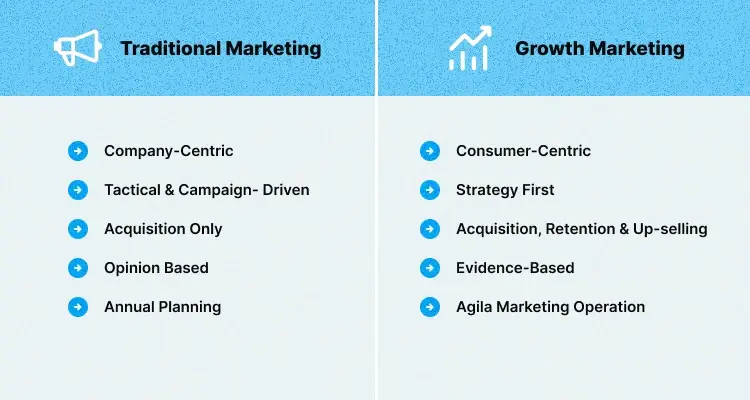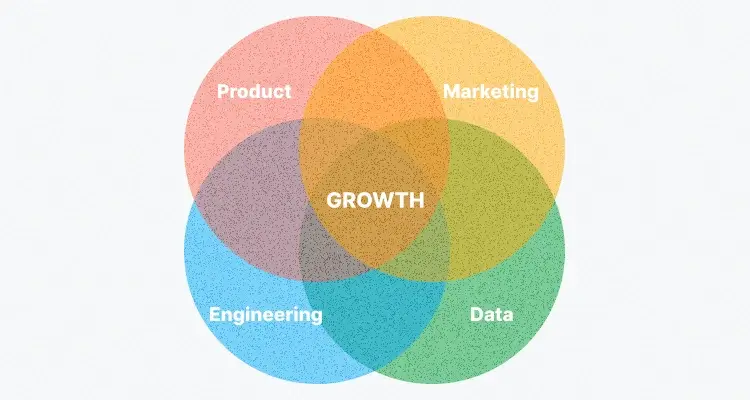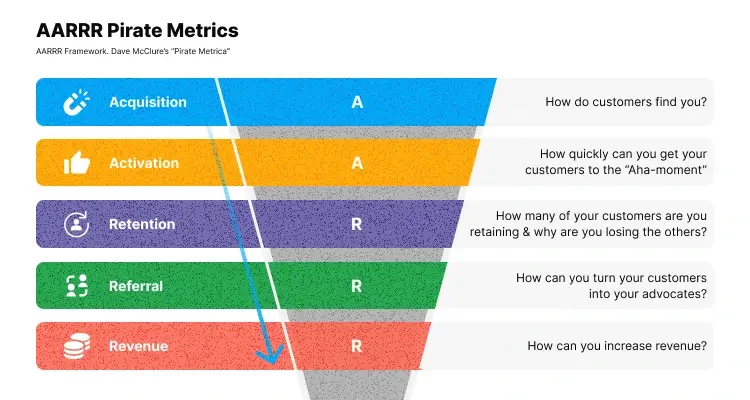In today's competitive business world, having a marketing strategy that can help you achieve rapid and sustainable growth is crucial. Traditional marketing methods, such as print ads or TV, have become less effective as consumers increasingly turn to digital channels. This is where growth marketing comes in – a data-driven marketing approach that aims to quickly and efficiently grow businesses. In this article, we'll explore the benefits of growth marketing and provide tips on implementing it effectively.
What is Growth Marketing Exactly?
Growth marketing is a marketing approach that prioritizes experimentation and data-driven decision-making to achieve rapid and sustainable business growth. This strategy offers a unique approach tailored to modern businesses' needs, allowing you to quickly adapt to changes in consumer behavior and market trends.
Let’s look at some data first:
- Growth marketing is among the top three areas in which budgets will be increased in the coming year
- 35% of the companies surveyed have tried to implement growth marketing practices, and 40% plan to do so soon
- 87% of organizations have felt the positive effects of growth marketing
How is Growth Marketing Different from Traditional Marketing?

Traditional marketing methods rely on mass communication to reach a broad audience. They often involve a one-way flow of information, with little opportunity for feedback or personalization. On the other hand, growth marketing focuses on targeted communication with specific customer segments, using data to identify the most effective channels and messaging. It involves a continuous process of experimentation and optimization, with a focus on driving customer acquisition and retention.
Advantages of Growth Marketing

Growth marketing offers several advantages over traditional marketing, including the following:
- Better decision-making: Growth marketing relies on a data-driven approach, eliminating the need to rely on gut feelings. By analyzing the data, you can make informed decisions about what works and doesn't work for your business.
- Improved brand perception: Growth marketing focuses on understanding the customer journey and delivering better experiences to build stronger customer relationships. By doing so, you can enhance your brand's perception among customers.
- Scalability: It is a scalable strategy, meaning you can scale up or scale back your marketing efforts according to your cash flow. This helps you to avoid blindly spending money on big campaigns.
- Team collaboration: Growth marketing requires collaboration between different teams, including marketing, product, sales, customer support, and analytics. This unification ensures that everyone is working towards the same goals.
- Revenue generation: The strategy focuses on achieving sustainable progress and driving revenue through agile goals. Instead of taking shots in the dark, growth marketing identifies promising targets and works towards achieving them strategically.
Growth Marketing Strategies
Now that we know more about growth marketing let's check out some strategies that we can apply:
A. Data-driven decision-making strategy: This approach involves using tools such as Google Analytics to track website traffic and customer behavior and A/B testing to test different versions of marketing materials and measure their effectiveness.
B. A/B testing and experimentation: A/B testing involves creating two versions of a marketing campaign or website and testing them with different segments of your audience to see which performs better. It allows you to make data-driven decisions about which messaging, visuals, and calls to action are most effective.
C. Customer segmentation and personalization: Growth marketing allows you to segment your customer base into specific groups based on demographic, geographic, or behavioral factors and tailor your messaging and experiences to each group. This can help you deliver more personalized and relevant content, improving customer engagement and retention.
D. Referral marketing and word-of-mouth: This strategy encourages your existing customers to refer new customers to your business. You can do it using discounts or complimentary products, and it can be a highly effective way to drive new customer acquisition.
E. Influencer marketing and collaborations: Influencer marketing involves partnering with individuals or brands with large followings on social media to promote your products or services. This can help you reach new audiences and build credibility and trust with your target audience. To know more about influencer marketing, read our article “Influencer marketing for crypto projects”.
Successful Cases of Growth Marketing
To illustrate the strategies above, let's study some examples of successful growth marketing cases where the companies managed to achieve their marketing goals:
- Dropbox: Referral marketing program - Dropbox offered its users free storage space to refer new users to the platform. This helped Dropbox grow its user base from 100,000 to 4 million in just 15 months.
- Airbnb: Personalized recommendations and user-generated content - Airbnb uses a data-driven approach to personalize its recommendations to users based on their search history and behavior on the platform. The company also encourages user-generated content, such as reviews and photos, to build trust and credibility with potential customers.
- Slack: Strategic partnerships and integrations - Slack has built partnerships with other business tools, such as Google Drive and Trello, and created a seamless user experience. This has helped Slack become the go-to communication tool for many businesses.
- And finally, the case with Casper: Casper, a mattress startup, has worked with influencers such as Kylie Jenner and targeted social media advertising to reach new audiences and build brand awareness. Thanks to that, Casper became one of the fastest-growing companies in the bedding industry.
Best Practices for Growth Marketing

So, how can you implement growth marketing strategies in your business? The AARRR framework, which is one of the most popular frameworks for growth marketing, can help you with it. This framework divides your marketing growth strategies into five stages and assigns metrics to map this journey:
- Acquisition: Turn viewers into leads and customers
- Activation: Create the “aha moment” where customers realize the true value of your business
- Retention: Keep customers coming back to purchase or staying subscribed
- Referral: Turn customers into brand advocates
- Revenue: Enhance customer lifetime value
In addition, it's important to continuously test and optimize marketing strategies, invest in customer experience and retention, and collaborate with other businesses and influencers to expand your reach.
Challenges and Limitations of Growth Marketing
Although growth marketing has immense potential, it does have certain limitations that should be acknowledged. Firstly, growth marketing involves taking risks and trying new things. This requires a culture of experimentation and a willingness to fail, which can be difficult for some businesses to embrace. Therefore, for growth marketing to be successful, companies need to foster a culture that encourages risk-taking and experimentation.
Secondly, growth marketing may not be suitable for all types of businesses or industries. Mainly, businesses with a smaller target audience or a low customer lifetime value may not benefit as much from growth marketing strategies. Thus, evaluating whether growth marketing is the best fit for a business before investing significant resources is important.
Lastly, implementing a successful growth marketing strategy requires significant time, resources, and expertise. This can be challenging for smaller businesses or those with limited marketing budgets. Thus, companies should carefully consider their ability to commit the necessary resources before pursuing a growth marketing strategy.
Conclusion
Growth marketing offers a unique marketing approach that can help businesses achieve rapid and sustainable growth through innovative and data-driven strategies. However, it also comes with challenges and requires significant time, resources, and expertise.

